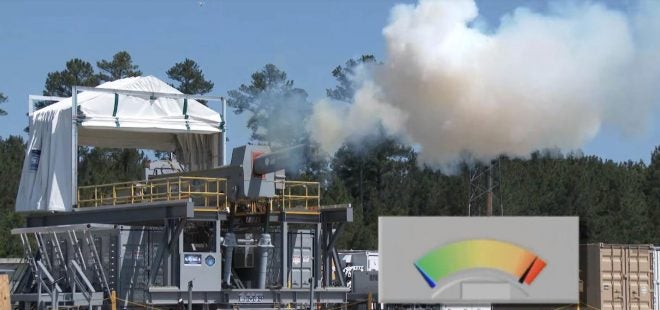Yes, you don’t own a flying car, but at least some of the promises of the future are coming true: The United States Navy has successfully tested its railgun prototype in multi-shot (autoloading) mode, earlier this summer. Although the US Navy has been testing railguns since 2006, this latest test was the first time such a weapon had fired multiple shots in quick succession, thanks to an autoloading mechanism fitted to the rear. You can see the railgun in action in the video below, released by the Office of Naval Research:
Railguns are powerful weapons. The ONR railgun is capable of producing over 32 megajoules of energy, about 1,800 times the energy produced by a .50 caliber M2 machine gun, although in the rapid fire tests it was limited to “just” 20 megajoules. In addition to producing as much energy as an 8″ L/55 naval cannon, railguns are capable of producing much higher velocities than conventional guns. While a large artillery piece of comparable power might be capable of producing up to 3,000 ft/s, railguns have been tested that produced velocities as high as 7,000 ft/s. This velocity is so high that the projectile arrives at the target almost instantaneously, has an almost completely flat trajectory even over tens of miles, and strikes the target with an explosion from the sheer amount of energy being exerted on the relatively small (10-20kg) projectile. Further, because of their favorable aiming characteristics and explosive impact, no sophisticated fuses or electronics are needed to ensure a hit or cause serious damage, nor is any propellant required, meaning a railgun is potentially much cheaper to operate than a conventional cannon or missile system.
Although railguns offer a considerable advantage due to their extremely high velocity and striking energy, they suffer from some very difficult to solve problems, as well. Railguns are energy intensive weapons, requiring substantial power sources. This means that such weapons, although perhaps practical for warships with large powerplants, are unlikely to become much smaller and more mobile any time soon. Also, their high muzzle velocity quickly wears out their “barrels” (which are actually two conductive metal rods along which the projectile is driven), requiring frequent replacement. The US Navy’s solution to this latter problem may be to simply make the rails out of inexpensive materials, and to design the guns so that they can be easily and quickly replaced.
The US Navy is eyeing the railguns as a potential replacement for their DDG-1000 Zumwalt’s 155mm Advanced Gun System.
 Your Privacy Choices
Your Privacy Choices
